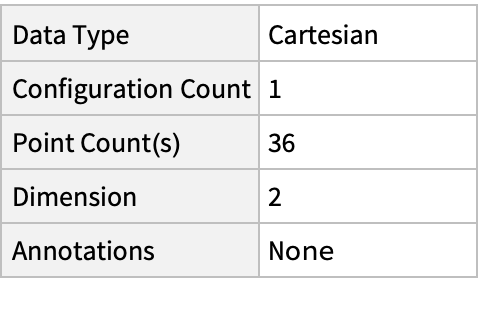Wolfram Data Repository
Immediate Computable Access to Curated Contributed Data
Locations of waterstrider larvae
| In[1]:= |
| Out[1]= |  |
Summary of the spatial point data:
| In[2]:= |
| Out[2]= |  |
Plot the spatial point data:
| In[3]:= |
| Out[3]= |  |
Visualize the smooth point density:
| In[4]:= |
| Out[4]= |  |
| In[5]:= | ![Show[ContourPlot[density[{x, y}], {x, y} \[Element] ResourceData[\!\(\*
TagBox["\"\<Sample Data: Waterstriders 3\>\"",
#& ,
BoxID -> "ResourceTag-Sample Data: Waterstriders 3-Input",
AutoDelete->True]\), "ObservationRegion"], ColorFunction -> "Rainbow"], ListPlot[ResourceData[\!\(\*
TagBox["\"\<Sample Data: Waterstriders 3\>\"",
#& ,
BoxID -> "ResourceTag-Sample Data: Waterstriders 3-Input",
AutoDelete->True]\), "Data"], PlotStyle -> Black]]](https://www.wolframcloud.com/obj/resourcesystem/images/beb/beb5eb57-1f25-4154-a57a-b3e5becd81d3/0b874efeb55df920.png) |
| Out[5]= |  |
Compute probability of finding a point within given radius of an existing point - NearestNeighborG is the CDF of the nearest neighbor distribution:
| In[6]:= |
| Out[6]= |  |
| In[7]:= |
| Out[7]= |
| In[8]:= |
| Out[8]= |  |
NearestNeighborG as the CDF of nearest neighbor distribution can be used to compute the mean distance between a typical point and its nearest neighbor - the mean of a positive support distribution can be approximated via a Riemann sum of 1- CDF. To use Riemann approximation create the partition of the support interval from 0 to maxR into 100 parts and compute the value of the NearestNeighborG at the middle of each subinterval:
| In[9]:= | ![step = maxR/100;
middles = Subdivide[step/2, maxR - step/2, 99];
values = nnG[middles];](https://www.wolframcloud.com/obj/resourcesystem/images/beb/beb5eb57-1f25-4154-a57a-b3e5becd81d3/1f7c5edcc5a2f4c1.png) |
Now compute the Riemann sum to find the mean distance between a typical point and its nearest neighbor:
| In[10]:= |
| Out[10]= |
Account for scale and units:
| In[11]:= |
| Out[11]= |
Test for complete spatial randomness:
| In[12]:= |
| Out[12]= |  |
Fit a Poisson point process to data:
| In[13]:= | ![Clear[\[Mu]];
EstimatedPointProcess[ResourceData[\!\(\*
TagBox["\"\<Sample Data: Waterstriders 3\>\"",
#& ,
BoxID -> "ResourceTag-Sample Data: Waterstriders 3-Input",
AutoDelete->True]\), "Data"], PoissonPointProcess[\[Mu], 2]]](https://www.wolframcloud.com/obj/resourcesystem/images/beb/beb5eb57-1f25-4154-a57a-b3e5becd81d3/7216be3dee983fd9.png) |
| Out[14]= |
Gosia Konwerska, "Sample Data: Waterstriders 3" from the Wolfram Data Repository (2022)